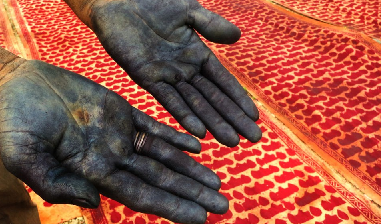- Home
- About US
- Art and Craft
- Artisans
- Master Crafts Persons
- Supporting Institutions
- News and Events
- Schemes
- Contact us
- Contact

Dabu printing- The lush earth , in an embrace with fabric, sprouts beautiful patterns. And the earthhad it’s playful ways, in slowly letting out this secret, to the Rangrez.It had lung onto his dhoti a day back at the riverside. He was deep in thought now,as he gathered the fabrics to be dyed. The dhoti went along with the rest
of the clothes, in the swift sweep of his hands and straight into the Indigo vat. He was surprised to find an odd-one-out the next day, amongst the dyed fabrics, left out to dry. The parts where the earth rested, the dye did not blot on. That part had retained the original colour, like stars in an indigo sky. This way, the earth confided a crumb of it’s mystery, to the Rangrez. And then on, they conversed in patterns.
This is one of the many stories of the origin of Dabu or Mud- resist printing. Like the craft, the raw materials too are timeless – mud and water. Replenished generously by nature, these are believed to have been employed in India, during8th century AD. This is indicated by the oldest specimen found of Dabu printed fabric in Central Asia.
The prints popularly adorned the flowing Ghagras. These were the favored clothing of the women, locally called ‘Fetiya’ in Rajasthan. This was
usually coupled with a Bandhej Lugda (a long fabric draped over the head).
Taking one long Dabu printed fabric with the preferred motifs of concernedcommunity, Fetiya was made with just one line of stitching. It was crafted by joining the extreme ends of a 8-12 meter fabric (the length varied with the buyer’s interest). The garment then beautifullyenveloped Jat, Gadariya & Gujjar women.
The patterns are traditional, handed down intact, over generations. The motifs are picked from nature and surrounding elements, and then crafted onto wooden
blocks. Popular ones are Kahma, Lal titri, Dholika, Kantedar. The craftsmen dip the blocks into a viscous paste of mud, gum and lime. The method gets it’s name from the word ‘dabaana’ , meaning ‘to press’
Earlier, Rajasthan province was densely peppered with Dabu printing clusters. Now, very few remain to live the legacy. One of the few clusters is theAkola village, which
thrives solely on the fabric demands of neighboring villages. The colors of the sky – blue of the day, indigo of the night, red of the sunsets – are mostly seen in the regional attire. The village is a self sufficient system for Dabu printing. Block carvers sculpt the blocks, the earth lends mud and the river bestows water. The fabrics are sourced from Kishangarh and pigments come from Udaipur.
Their craft speaks of skill and years of experience, as the craftsmen swiftly pattern the clothes. The application of resist and dye are done several times, painstakingly with great artistry, to get various shades of ground and motif color. As time passed, Alizarin pigment used to impart red color was replaced by Naphthol and the craftsmen began to use tar instead of mud in case of designs which require sharper contrasts.
As told by Master craftsman Gopal Bhai, the native craftsmen known as Chippas, specialize in block printing. Few hundred years ago, Rani Rathorji of Mewar, established a village by the banks of Beduch river for them. Today around 200 people practice this craft in this quaint village
Akola (आकोला), also known as Chhipo ka Akola, is a village in Bhupalsagar tehsil of Chittorgarh district in the Indianstate of Rajasthan.
Location-It belong to Udaipur division. It is located 52 km towards west form district headquarters chittorgarh, 13 km from Bhopalsagar, 339 km from state capital Jaipur. Akola is surrounded by kapasan tehsil towards North, Mavli tehsil towards west, Bhinder tehsil towards south, Railmagra tehsil towards North. Akola, located 70 km away from the city of Udaipur is home to color and hand print industries. Several families for generations have been engaged in this art to earn livelihood with self employment. The dabu or mud resist printing of this region is of two specific types namely nangna and phetiya. The resist is made by local gum/bedja and oil by boiling it for several hours. the main Products are Phetia and Chunder, which are mainly used by agriculture class women of Chittorgarh, Bhilwara, Udaipur,and Ajmer districts. Now this market is shrinking so the handprint business has penetrated into new products markets(Dress Material, Stoles, Dupattas, Sarees, Bed sheets). The USP of Akola is hand block printing and Eco-friendly dyes which is favorite of high profile people and high income generating people because they understand the block printing is an art and not a process.